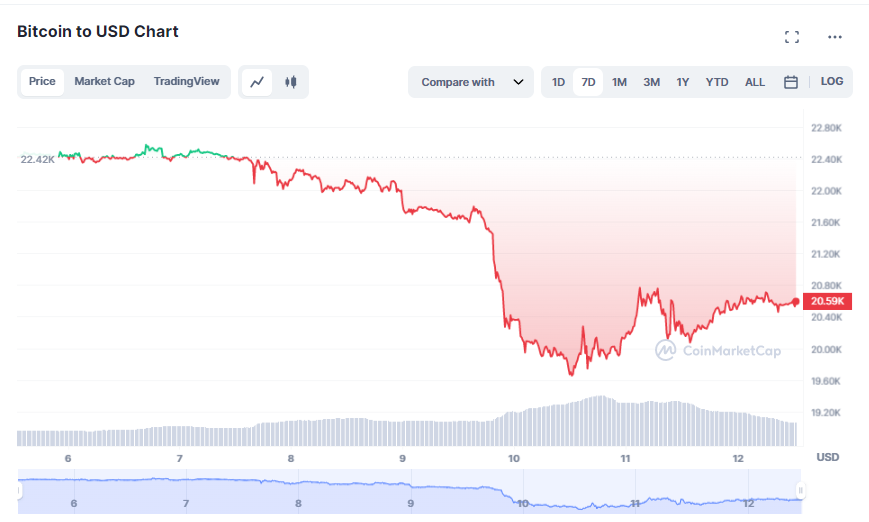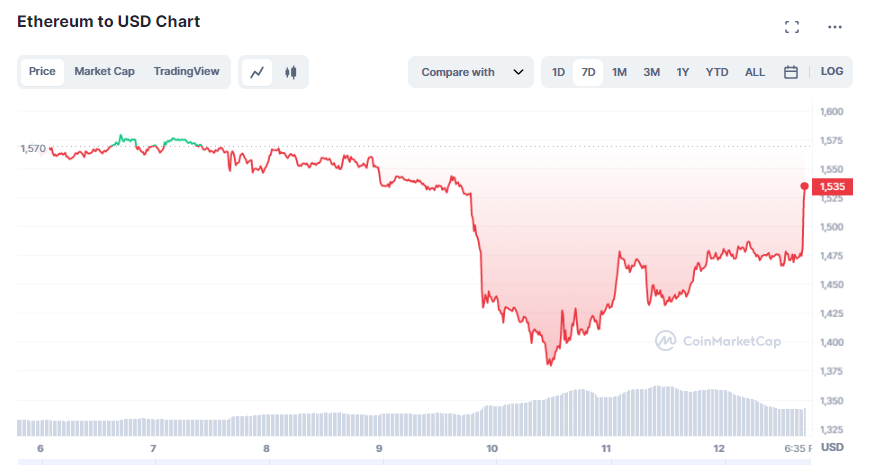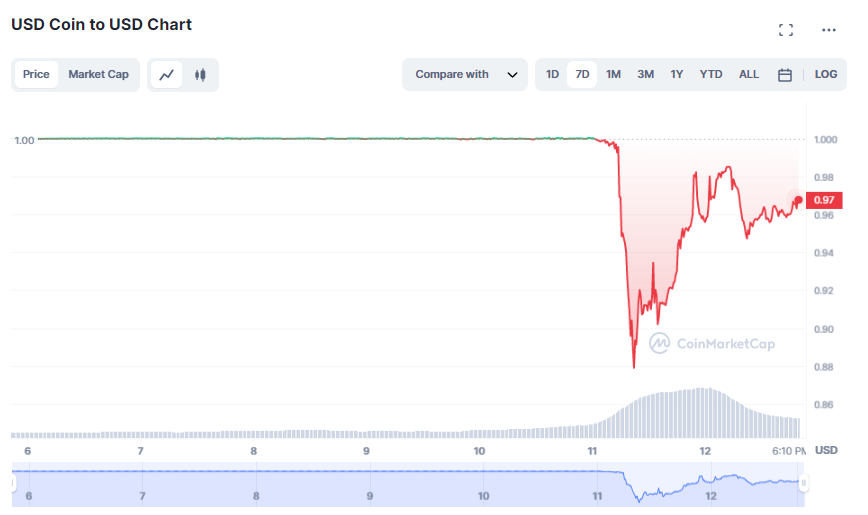The Silvergate Bank Collapse
After it was announced Wednesday 8 March that the crypto-friendly bank, Silvergate Bank, would be shutting down operations and voluntarily liquidating, there has been some impact on the crypto market and potential impact on the crypto industry. As stated in the announcement by Silvergate Capital Corporation, Silvergate Bank’s holding company, the wind down and liquidation plan includes full repayment of all deposits. Also, Silvergate Bank is discontinuing the Silvergate Exchange Network (SEN). Meanwhile, all other deposit-related services remain operational, says Silvergate Capital Corporation.
Before the Silvergate Bank liquidation announcement, the crypto market had been experiencing a market-wide depreciation. After the announcement, there has been further depreciation of cryptoassets but the impact has been minimal. This relatively minimal impact on cryptoassets price movement seems to suggest that crypto investors must have priced the Silvergate Bank liquidation news when the Silvergate Bank first warned that its SEN program may be shut down. (Through SEN, Silvergate Bank offers access to capital through U.S. dollar loans collateralized by bitcoin.
Apart from the announcement that Silvergate’s SEN program may be shut down, the news that Silvergate Bank delayed filing its annual 10-k report with the United States Securities and Exchange Commission (U.S. SEC) had earlier raised concerns. Lawmakers were also looking at the situation. Recall that Silvergate lost $1 billion in the closing quarter of 2022 due to the recent FTX collapse. (FTX crypto exchange was a leading customer of Silvergate.) These concerns stimulated some level of speculation in the crypto market.)
The Silicon Valley Bank Collapse
The 16th largest bank in the United States, Silicon Valley Bank on 9 March 2023 became the biggest US lender to fail since 2008. Silicon Valley Bank was the banker to private equity and venture capital firms mainly focused on tech and healthcare.
The immediate cause of Silicon Valley Bank collapse was a bank run whereby many customers started withdrawing their cash from the bank until it collapsed on Friday. According to reports, some Silicon Valley Bank customers got wind of the news that the bank was selling $21 billion of securities from its portfolio in order to meet customer withdrawals. In a letter from Silicon Valley Bank CEO to shareholders on Wednesday, the bank outlined a fundraising plan for $2.25 billion as it had lost $1.8 billion to the sale of US treasuries and mortgage-backed securities. On Thursday 9 March alone, customers withdrew up to $42 billion.
The remote cause however is the US Federal Reserve’s increase of interest rate in order to fight inflation. Silicon Valley Bank had bought government bonds which largely have fixed rates. More than 50% of its assets were in bonds. As interest rates increased, the cost of private capital increased. In order to meet liquidity needs, some of Silicon Valley Bank’s clients started withdrawing their funds.
Due to the Silicon Valley Bank collapse, the second largest US dollar-backed stablecoin USDC depegged from the dollar. USDC has a market valuation of $42 billion. Silicon Valley Bank is a banker to Circle, the issuer of USDC. USDC/USDT trading pair fell to as low as $0.89.
Impact on bitcoin price. Down by 20%
Before the Silvergate Bank liquidation announcement, bitcoin (BTC) price was about $22,420 on 7 March 2022, 9:10am. After the announcement on 8 March, BTC price had fallen to about $21,980.
On 9 March, BTC price had fallen further to about $20,270. BTC kept slumping till it hit about $19,655 on 10 March, losing its $20,000 support. This represents over 10% loss. Obviously, the combined news of Silicon Valley Bank collapse had also started having some serious impact on the crypto market at this point.
At the time of writing, BTC price has gradually risen to about $20,590, according to Coinmarketcap data. BTC is expected to sit at its $20,000 support.

Impact on Ethereum Price. Down by 9.5%
Similarly, Ethereum (ETH) price was about $1,570 on 7 March. The price didn’t seem to have been affected after the Silvergate Bank liquidation news as the price was about $1,550 by the end of 8 March.
It was not until about 3:20pm on 9 March that ETH price started experiencing what resulted in a noticeably sharp drop from about $1,540 to about $1,445, and then fell further to about $1,380 on 10 March, down by about 9.5%.
At the time of writing, ETH has significantly recovered, trading at the price of about $1,530 per coin, according to Coinmarketcap data. Currently trading at an ascending triangle pattern, ETH has risen back to its previous $1,500 support.

Impact on AVAX, LINK, DOT, MATIC, SHIB, and UNI prices. Down by up to 15%.
According to Coingecko data, Avalanche (AVAX), Chainlink (LINK), Polkadot (DOT), Polygon (MATIC), Shiba Inu (SHIB), and Uniswap (UNI) all lost up to 15% due to the combined Silvergate Bank and Silicon Valley Bank news.
Impact on DOGE, FIL, OKB, and SOL. Down by 20% or more
Losses with up to 20% or more were experienced by Dogecoin (DOGE), Filecoin (FIL), OKB, and Solana (SOL) investors or holders.
Impact on USDC stablecoin by Circle. Down to $0.89
From $1.0002 USD Coin (USDC) to USD price by 12 midnight on Saturday 11 March, the USDC/USD trading pair fell to as low as $0.89 by 9:20am on the same day.
At the time of writing, USDC price has risen to 0.97, according to Coinmarketcap data.

Related: Introduction to Stablecoins: USDT, USDC, and BUSD
Related: USDC will remain redeemable 1 for 1 with the U.S. Dollar, Circle assures users.
Impact on the Crypto Industry
Regulators’ reaction to the relationship between the crypto ecosystem and the banking sector
Apart from cryptoasset price movements as seen in the crypto market above, Silvergate Bank’s collapse will most likely impact regulators’ approach to the relationship between the crypto ecosystem and the banking sector. This is because post-FTX collapse, regulators, particularly in the U.S., have been increasingly concerned about the risks involved in regulated financial institutions, including banks, providing banking and financial services to crypto exchanges and other crypto service providers.
Since Silicon Valley Bank has now collapsed, the proportion of the US dollar deposited by Circle with the bank is basically unaccessible or unavailable. This puts a question mark on USDC’s ability to serve as a coin for maintaining stability in the ever-volatile crypto market. Following the problems Silvergate Bank had started facing, Circle had earlier announced that it was severing relations with Silvergate Bank.
Regulators’ joint statement on crypto-asset risks to banking organizations
In January 2023, the Federal Reserve, Federal Deposit Insurance Corporation (FDIC), and the Office of the Comptroller of the Currency, jointly warned banks to be cautious when dealing with crypto businesses. According to the joint statement issued by the trio, “[b]anking organizations should ensure that crypto-asset-related activities can be performed in a safe and sound manner, are legally permissible, and comply with applicable laws and regulations, including those designed to protect consumers (such as fair lending laws and prohibitions against unfair, deceptive, or abusive acts or practices)”.
Silvergate Bank collapse as a crypto problem, from regulators’ lens.
On the one hand, regulators, particularly in the U.S., will, rightly or wrongly, treat Silvergate Bank collapse as a crypto problem. Consequently, these regulators will take more actions against crypto adoption particularly in the banking and financial system.
On the other hand, Crypto industry leaders believe that Silvergate collapse is largely caused by classic banking risk rather than Silvergate’s exposure to the crypto industry. According to Caitlin Long, founder & CEO of Custodia Bank, Silvergate’s lack of cash deposits to enable it to meet customers’ withdrawal requests is the major cause of the collapse.
Angelo Calvello, Ph.D., co-founder of Rosetta Analytics, believes that Silvergate collapse is a traditional finance (TradFi) problem. According to Calvello, “long before November there were the fundamental problems with Silvergate that traditional analysts failed to detect, or at least grossly underestimated”. As reported by CoinDesk, Calvello was quoted to have said as follows:
Some are quick to point out that Silvergate is a banking failure, not a crypto failure. But I see it as yet another TradFi failure: Like the institutional investors who invested in failed lender Celsius Network and FTX, Silvergate analysts used traditional investment techniques and metrics to assess the value of a nontraditional company, causing them to miss the embedded crypto risks that ultimately caused the company’s failure. If we are going to stop the crypto carnage, we need TradFi to put on a DeFi lens.
Discover more from Crypto Asset Buyer
Subscribe to get the latest posts sent to your email.




